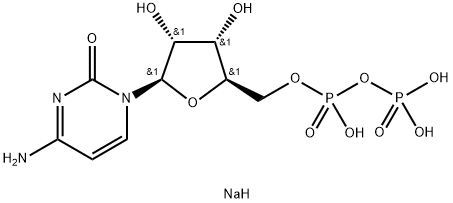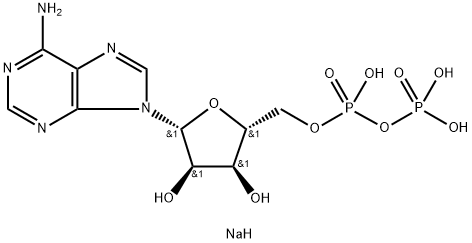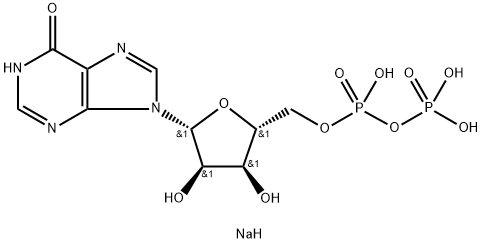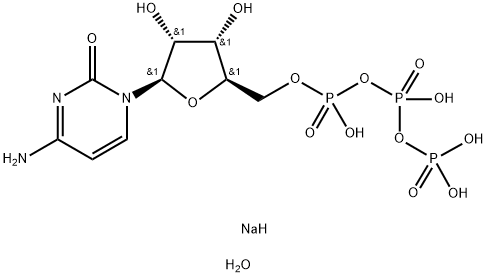Cytidine 5'-diphosphate trisodium salt
Synonym(s):CDP sodium salt hydrate
- CAS NO.:34393-59-4
- Empirical Formula: C9H16N3NaO11P2
- Molecular Weight: 427.17
- MDL number: MFCD00065201
- EINECS: 251-990-8
- SAFETY DATA SHEET (SDS)
- Update Date: 2025-12-26 16:58:18

What is Cytidine 5'-diphosphate trisodium salt?
Chemical properties
White crystalline powder
The Uses of Cytidine 5'-diphosphate trisodium salt
Cytidine 5′-diphosphate sodium salt hydrate has been used:
- as a substrate in nucleoside diphosphatase (NDPase) enzyme histochemistry assay of gold fish eye sections
- in ribonucleotide reductase assay
- dCDP formation assay.
The Uses of Cytidine 5'-diphosphate trisodium salt
Cytidine 5'-Diphosphate trisodium salt is a diphosphate nucleoside derived from Cytidine (C998300). An inhibitor of glycogenin-catalyzed glucosyl and xylosyl transfer It is used as a therapeutic agent in treatment prevention of myocardial isc hemia accompanied with cerebral ischemia.
General Description
Cytidine 5′-diphosphate (CDP) is synthesized from cytidine monophosphate (CMP) or uridine monophosphate (UMP) by the transfer of phosphoryl group, catalyzed by the enzyme uridylate kinase (UMPK). CTP synthetase catalyzes the conversion of CTP to CDP intermediates like CDP-diacylglycerol, CDP-choline and CDP-ethanolamine for phospholipid biosynthesis.
Biochem/physiol Actions
Cytidine 5′-diphosphate (CDP) is used as a substrate of nucleoside diphosphatase kinase to produce CTP for supporting DNA and RNA biosynthesis and of ribonucleotide reductase to product dCMP.
Properties of Cytidine 5'-diphosphate trisodium salt
| storage temp. | Keep in dark place,Inert atmosphere,Store in freezer, under -20°C |
| form | Crystalline Powder |
| color | White |
| Water Solubility | Freely soluble in water, insoluble in ethanol, chloroform and ether. |
Safety information for Cytidine 5'-diphosphate trisodium salt
| Signal word | Warning |
| Pictogram(s) |
 Exclamation Mark Irritant GHS07 |
| GHS Hazard Statements |
H302:Acute toxicity,oral H315:Skin corrosion/irritation H319:Serious eye damage/eye irritation H335:Specific target organ toxicity, single exposure;Respiratory tract irritation |
| Precautionary Statement Codes |
P261:Avoid breathing dust/fume/gas/mist/vapours/spray. P305+P351+P338:IF IN EYES: Rinse cautiously with water for several minutes. Remove contact lenses, if present and easy to do. Continuerinsing. |
Computed Descriptors for Cytidine 5'-diphosphate trisodium salt
New Products
4,4-Difluoropiperidine hydrochloride tert-butyl 9-methoxy-3-azaspiro[5.5]undecane-3-carboxylate Indole Methyl Resin N-Isopropylurea N,N-Dicyclohexylcarbodiimide(DCC) MELDRUMS ACID 5-METHYLISOXAZOLE-4-CARBOXYLIC ACID Magnessium Bis glycinate Zinc ascorbate 1-bromo-2-butyne 2-acetamidophenol 9(10H)-anthracenone Erythrosin B, 4-Piperidinopiperidine 2-((4-morpholinophenylamino) (methylthio) methylene) malononitrile 2,4-dihydroxybenzaldehyde 3-(4-morpholinophenylamino)-5-amino-1H-pyrazole-4-carbonitrile Methyl 2-methylquinoline-6-carboxylate 2,6-dichloro-4-nitropyridine 4-Bromo-2-chlorobenzonitrile 2-(benzylamino)acetic acid hydrochloride 4-(tert-Butoxycarbonylamino)but- 2-ynoic acid 3,4-dihydro-2H-benzo[b][1,4]dioxepine 1-Phenyl-1-cycloprppanecarboxylicacidRelated products of tetrahydrofuran








You may like
-
 Cytidine 5'-Diphosphate Trisodium Salt CAS 34393-59-4View Details
Cytidine 5'-Diphosphate Trisodium Salt CAS 34393-59-4View Details
34393-59-4 -
 Cytidine-5'-diphosphate trisodium salt 97% CAS 34393-59-4View Details
Cytidine-5'-diphosphate trisodium salt 97% CAS 34393-59-4View Details
34393-59-4 -
 Cytidine 5′-diphosphate sodium salt hydrate CASView Details
Cytidine 5′-diphosphate sodium salt hydrate CASView Details -
 3-(4-amino-1-oxoisoindolin-2-yl)-1-methylpiperidine-2,6-dione 98%View Details
3-(4-amino-1-oxoisoindolin-2-yl)-1-methylpiperidine-2,6-dione 98%View Details -
 20677-73-0 (2,2-diethoxyethyl)methylamine 98%View Details
20677-73-0 (2,2-diethoxyethyl)methylamine 98%View Details
20677-73-0 -
 3-(4-(hydroxyamino)-1-oxoisoindolin-2-yl)piperidine-2,6-dione 98%View Details
3-(4-(hydroxyamino)-1-oxoisoindolin-2-yl)piperidine-2,6-dione 98%View Details -
 57381-49-4 2-bromo-4-chlorobenzonitrile 98%View Details
57381-49-4 2-bromo-4-chlorobenzonitrile 98%View Details
57381-49-4 -
 4,6-dichloropyrimidine-5-carbaldehyde 98%View Details
4,6-dichloropyrimidine-5-carbaldehyde 98%View Details
5305-40-8
